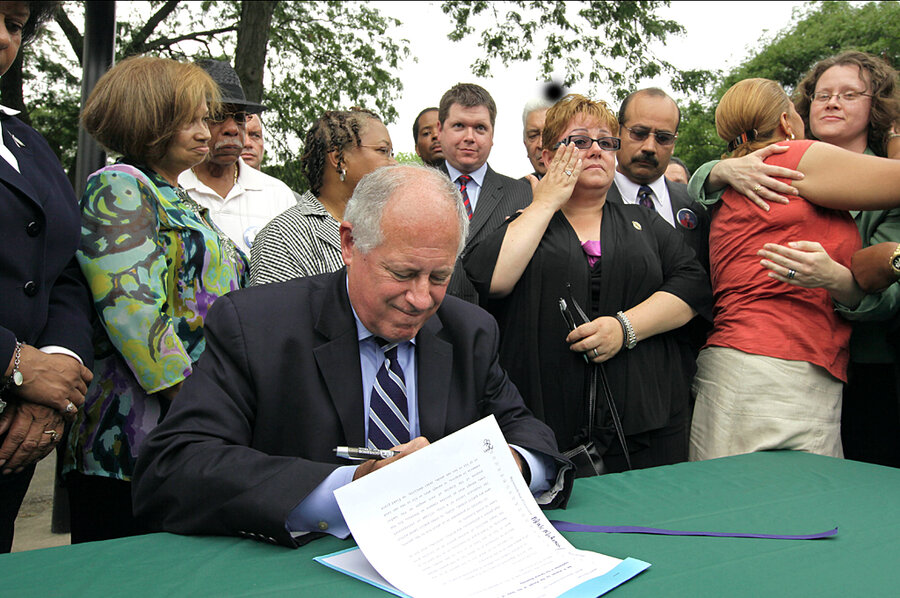Behind Chicago's high-crime summer: persistent street gang violence
Loading...
| Chicago
With three police officers killed in separate instances in two months, and calls from some Illinois lawmakers for the National Guard to patrol its most violent streets, Chicago once again finds itself under growing pressure to rein in crime.
Although this year hasn't been Chicago's worst, the police murders have brought new attention to the city's stubbornly high homicide rate, which experts say is the result of a chronic gang problem and budget cutbacks that have reduced the number of officers patrolling tough neighborhoods.
As of Aug. 12, the homicide count was 273, more than half last year's total of 458. While that number is down significantly from the years when Chicago's homicide numbers exceeded 900, it still far outpaces murder rates in other big American cities. Los Angeles, a larger city than Chicago by a million residents, reported 313 homicides last year, according to the FBI.
Chicagoans were alarmed this summer after a series of murders, including the death of an 8-year-old girl who was shot by a stray bullet while skipping rope, an unintended victim in a heated gang war. In July, a Chicago Tribune/WGN poll found that half of those surveyed felt that violence here was getting worse.
"Mayor [Richard M.] Daley needs to send the National Guard over here," says Erika Bernadin, a mother of six who lives in Roseland, a far South Side neighborhood with the highest number of gun deaths this summer. "There ain't nothing to do here but listen to the sad stuff on the news."
Mayor Daley is trying to get more officers on the streets. To make up for a 15 percent drop in police from 2008, he is seeking federal grant money to increase hires.
Last year he started moving officers on desk duty to street patrol, a tactic that was criticized in July when one of those officers, an 11-year training instructor at the police academy, was killed with his own gun after a man wrestled it away from him.
"There's no question that both the patrolling strength and the strategies in police departments make a difference in reducing crime," says Harold Pollack, a codirector of the Chicago Crime Lab at the University of Chicago. What's more, he says, federal, state, and local budget problems are creating "serious challenges" to making streets safe.
"We're missing a big policy opportunity to help, not only with increasing the size of the police, but with doing other violence-intervention efforts like youth employment," says Mr. Pollack.
Chicago's gang problem is greater than that in either New York City or Los Angeles, according to Philip Cook, who studies violence at Duke University's Sanford School of Public Policy in Durham, N.C. Chicago Police Department statistics show that 81 percent of homicides in the first seven months of this year were gang-related, which Mr. Cook says confirms his research that despite policing efforts, gun access is flourishing among Chicago's gangs.
"Generally, Chicago does a good job in controlling guns and long placed a very high priority on that. But gangs have always been the exception," he says.
Gang warfare intensified in Chicago over the past 15 years as a result of the dismantling of public housing projects like Cabrini-Green and the Robert Taylor Homes. Residents were scattered across the edges of the city, opening new turf battles as gangs fought to control drug markets.
"When the gangs left the projects and tried to reestablish themselves in other places, there was violence everywhere, and it didn't drop," says John Hagedorn, a criminal justice professor at the University of Illinois at Chicago who studies gangs.
Chicago and New York City shared similar homicide rates for decades until the mid-1990s, when New York's dropped the same time Chicago's climbed. The reason has to do with how both cities tackled public housing a decade earlier, says Mr. Hagedorn. In what remains the largest US urban housing initiative in history, New York spent $5 billion to build or renovate about 182,000 housing units, which helped populate formerly distressed neighborhoods like the South Bronx that, over time, improved as residents strengthened their ties to local businesses and schools.
Chicago residents were not given that opportunity. Instead of reinforcing its housing, the Chicago Housing Authority demolished its major projects and relocated residents to remote and often impoverished pockets of the city that Hagedorn says hardened its racial and economic barriers.
"New York invested in housing and Chicago didn't," he says. The dislocation process, which is in its last throes today, also coincided with the shifts in property values: It is not lost on many former Cabrini-Green residents that the site of their former apartments now sits across the street from million-dollar condo developments and upscale retail districts.
"[The former projects] became prime territory for redevelopment," Hagedorn says.
The result of Chicago's endeavor is that gangs became entrenched in the neighborhoods on the South and West sides, which over time led to the evolution of intragang warfare that is making matters worse.
'The only thing that's different now is you don't have the traditional gang on the street; it's factions and subsets and splinter groups that form cliques on the blocks and feel they're untouchable because no one can govern them," says Tio Hardiman, director of CeaseFire Illinois, an outreach group that organized six peace summits among gang members this year.
The heightened gang wars in Chicago this summer prompted FBI Director Robert Mueller to say new approaches to fight crime there are needed. "We have tried across the country a variety of techniques. My belief is that in Chicago we've tried just about every one of them," Mr. Mueller said in late July. "In comparison to the extent of the problem, it's inadequate."





